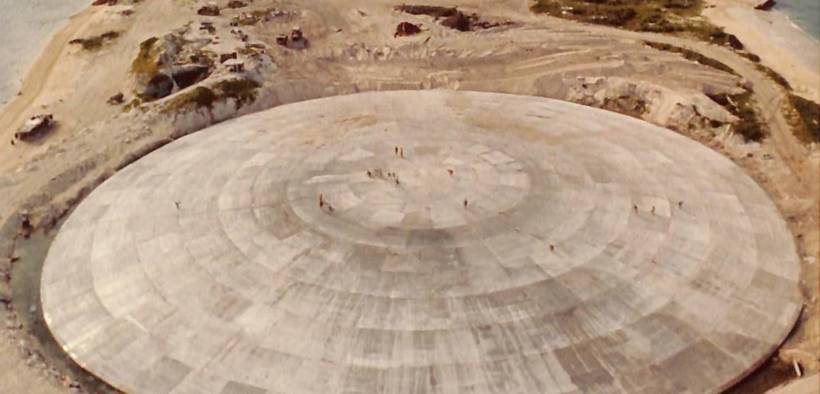How Safe is the U.S.’s Nuclear Waste Dump in the Marshall Islands?

In June the U.S. Department of Energy published the Report on the Status of the Runit Dome in the Marshall Islands. The report claims that the decades old nuclear waste dump in the Marshall Islands is safe, but serious questions remain.
America’s Nuclear Waste in the Marshall Islands
The Republic of the Marshall Islands is a sovereign nation located in Pacific about 2400 miles west of Hawaii. From 1946 to 1962 the U.S. government conducted dozens of nuclear tests there. Bikini Atoll is the most famous test site. Hundreds of Marshallese citizens were removed from their homes, several small islands were completely destroyed, and large parts of the country will never be safe for human habitation again. The tests also created tons of nuclear waste. Radioactively contaminated soil and debris was dumped into a crater from bomb, known as Cactus Crater, on Runit Island, part of the Enewetak Atoll. The Runit Dome was built over the site in the late seventies and early eighties and contains over 100,000 cubic yards of assorted nuclear waste, including plutonium. Over 600 hundred Marshallese currently live on Enewetak Atoll.
The Marshallese government officially took control of the dome in 1986 and since then any attempts to engage with the U.S. government over concerns about it have been rebuffed. Rising sea levels have created new worries over the current and long-term stability of the structure. In November of last year the LA Times published on extensive piece on the past and future of the Marshall Islands. During their interview for the piece with President of the Marshall Islands Hilda Heine, Heine expressed frustration with the U.S. Government’s failure to take responsibility for the Runit Dome: “How can it be ours? We don’t want it. We didn’t build it. The garbage inside is not ours. It’s theirs.”
The Runit Dome Report
The Energy Department’s Report on the Status of Runit Dome in the Marshall Islands was mandated by the 2019 National Defense Authorization Act. The Report concluded that “The Runit Dome is not in any immediate danger of collapse or failure, and the exterior concrete covering the containment structure is still serving its intended purpose, effectively reducing the natural erosion of the waste pile below by wind and water.” However, some pressing questions about the dome’s safety were not definitively answered by the report. That combined with issues with its methodology have left many unconvinced that the waste dump is not a threat to people and the environment.
Rising sea levels and increasingly severe storms are two of the impacts of climate change that are going to have the biggest impacts on the low-lying atolls of the Marshall Islands, even without the threat of nuclear waste leaking. The Report was not able to provide strong assurance that the waste beneath the Dome would remain contained in these conditions. It concluded:
“The most notable and immediate impact of rising sea levels on the Cactus Crater containment structure is that associated with the physical effects of storm surge and wave-driven flooding. DOE’s proposed groundwater radiochemical analysis program is designed to provide some understanding of possible effects of forcing events, such as storm surge, on changes in groundwater quality. It is anticipated that any measured or modeled effects of storm events may help provide a better understanding of the long-term consequences of sea level rise on the mass-transport of dome-derived radionuclidesinto the environment.”
In late July Hawaii Representative Tulsi Gabbard criticized the Report and asked for new research into the Dome’s safety. One of the issues brought up by Gabbard was the narrow range of sources used by the Department of Energy in the Report. Of the 27 papers referenced in the report 13 are by the same author, and 25 of them did not undergo peer review.
What if the dome is not safe?
In July of 2019 researchers from Columbia University documented radiation levels at former test sites around the Marshall Island that were as high or higher than those at nuclear disaster sites Chernobyl and Fukushima. During several visits to the Marshall Islands in 2018 and 2019 teams from the LA Times and Columbia University’s Graduate School of Journalism documented “extensive coral bleaching, fish kills and algae blooms — as well as major disease outbreaks, including the nation’s largest recorded epidemic of dengue fever.” It was hoped that release of the report could provide some definitive clarification about if any of these things are linked to the Dome. Unfortunately it lacks the depth and breadth of research to provide a convincing answers to these and other questions.
The Runit Dome may in fact be safe and keeping the nuclear waste contained for now, or it may not. And it may or may not be vulnerable to sea level rise and storm surge in the future. Getting clear and timely answers to questions about whether the Dome is leaking, if it’s going to start, how much, and where the radiation could go is of extreme importance and could mean the difference in preventing a major nuclear disaster, or not.







